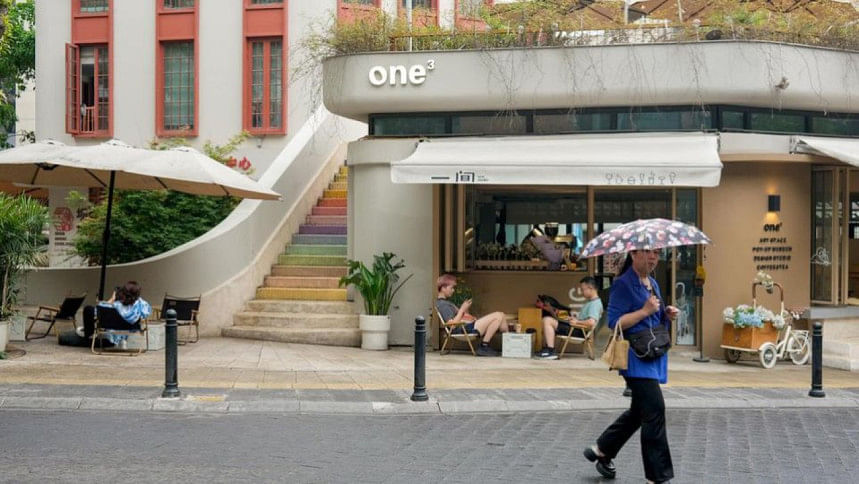China doubles down on urban upgrades to buck ‘consumption downgrade’

A pink entryway decorated with neon lights, stars and a rainbow greets visitors to Minzhu Village – home to some 8,000 residents in south-western Chongqing municipality.
Many visitors drop by the village for affordable meals, cheap haircuts or trendy tea houses and cafes. Lunchtime queues are long, with a wait of up to 20 minutes, as nearby office workers visit the village's canteen for lunch.
Such crowds were unthinkable just a few years ago before the village underwent refurbishment, said Mr Huang Chunchu, 65, who grew up in the village built in the 1950s.
Mr Huang, who is now retired, told The Straits Times: "Minzhu Village was shabby and quite lifeless".
Minzhu Village, which started upgrading works in 2022, is part of a renewed push across China to refresh residential areas in a bid to drive consumption in the world's second-largest economy. In Chongqing alone, renovation work started in 2,620 residential compounds in 2024, according to local media reports.
Held up as a success case, Minzhu village hosted Chinese President Xi Jinping when he visited Chongqing in April 2024. Mr Huang estimates that "about a hundred shops, including all the stalls in the wet market, and tea houses, cafes and restaurants have been added to the village".
In China, urban renewal projects have gained new urgency as Beijing makes boosting domestic demand its top priority for 2025 amid the trade war with the United States. But getting people to spend has been a challenge amid a "consumption downgrade", arising from an expected slowdown in the global economy due to geopolitical tensions.
On Jan 4 this year, a meeting of China's top leaders in the State Council, China's Cabinet, presided by Premier Li Qiang, stated that urban renewal "serves as an important lever for expanding domestic demand".
"The renovation of old residential communities, blocks, factory areas and urban villages in cities should be accelerated, and renovation of infrastructure should be strengthened," said a read-out after the meeting.
In 2024, China started more than 60,000 urban renewal projects – totalling 2.9 trillion yuan ($400 billion) – up from the 53,000 initiated in 2023.
The upgrades, which can range from updating water pipes and installing lifts to injecting commercial spaces into residential areas, are supposed to be completed within three years.
Compared with 2024, the official notice for this year's upgrading included a push to "strengthen infrastructure for consumers and to increase efforts to boost consumption".
The Finance Ministry said in April that "priority will be given to mega and super large cities, as well as large cities along key river basins such as the Yellow River and the Pearl River".
Municipalities, along with cities in China's western region, can receive up to 1.2 billion yuan in subsidies for upgrading projects. Those in the central region can get up to one billion yuan – 200 million yuan more than urban areas in the wealthier east.
Ms Shan Guo, a partner at business consultancy Hutong Research, said that urban renovation, though mainly led by the government, also draws private investment and boost gross domestic product growth.
"The commercialisation in these renovated areas also helps to create jobs and drive domestic demand," she added.
One of China's more successful upgrades of an urban village is Guangzhou's Yongqing Square – an arcade street built in 1931 in the capital of Guangdong province. After two rounds of renovations in 2016 and 2019, the street completed works in 2023.
Local media reported in 2024 that footfall in Yongqing Square – which features the ancestral residence of the late martial arts star Bruce Lee, the Cantonese Opera Art Museum as well as shops – rose by 12 per cent year on year, with commercial revenue growing by 24 per cent within the same period.
At Minzhu Village, the second and final phase of renovations completed in January 2025 included the construction of a new commercial complex measuring 7,500 sq m that houses some 70 shops.
Other amenities include barber shops offering five yuan haircuts, a canteen offering meals from seven yuan, a community clinic and a rest stop for delivery riders – complete with charging points, water and brochures on employment rights.
Mr Huang, who used to work in the factories in Minzhu Village, said: "I have all my meals at the canteen. The food there is cheap and nutritious."
He said the changes have "brought a lot of convenience to my daily life, and helps older people living here not feel so isolated, given the increased traffic flow from visitors and tourists".
Artist Zhou Zhengmao, who grew up in Minzhu Village and later studied in Italy, decided to set up a studio in the village to offer art lessons and sell oil paintings as he liked its neighbourly vibes.
Mr Zhou, who is in his 30s, said: "Everyday life inspires art, and that's why being in a neighbourhood is best for my studio."
Jiazhou Gardens is another residential compound in Chongqing that has undergone urban renewal.
Work to repaint buildings and widen the roads was carried out after a huge fire broke out in 2020 at the compound, an upscale residential area built in the early 1990s and 2000s.
Ms Oriole Huang, a resident of Jiazhou Gardens who is in her 30s, opened a cafe there after its refurbishment in 2020. The cafe broke even after just 10 months of operations and attracts both locals and visitors.
She said of Jiazhou Gardens: "The compound is now clean and well-maintained, especially the old trees. That's what made me feel like the area had real potential."

 For all latest news, follow The Daily Star's Google News channel.
For all latest news, follow The Daily Star's Google News channel. 



Comments